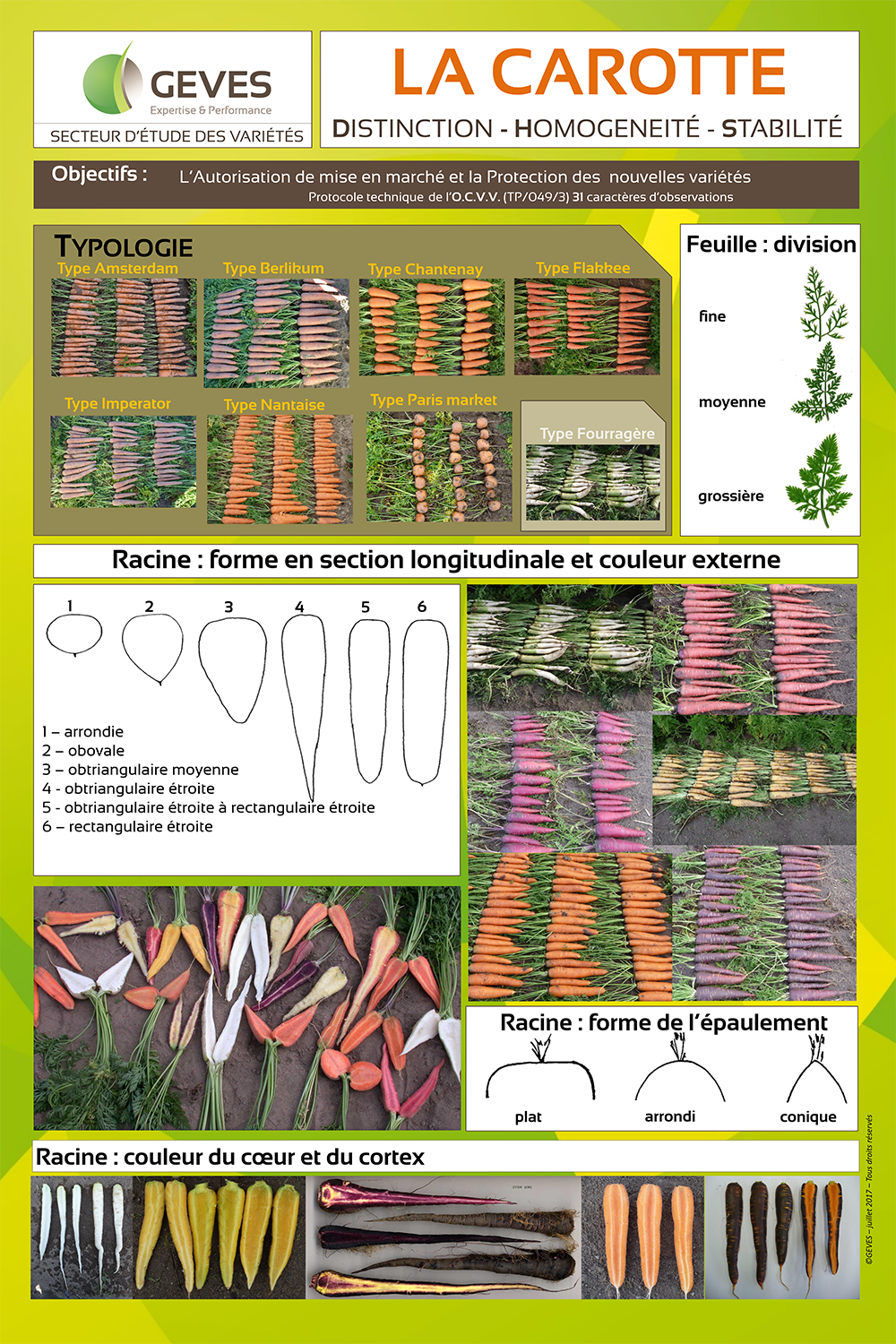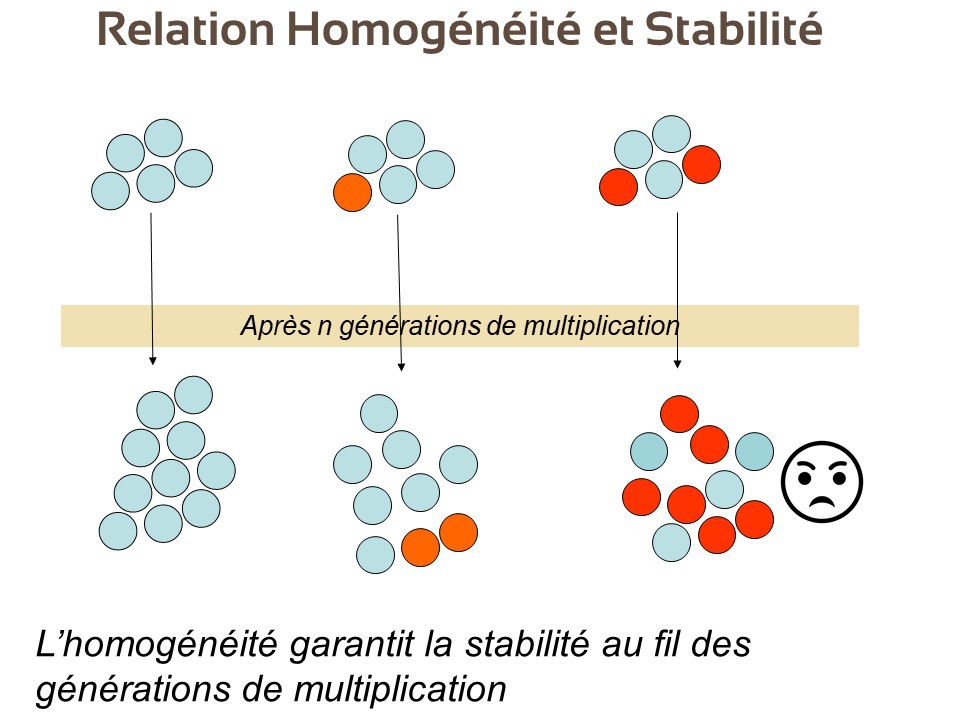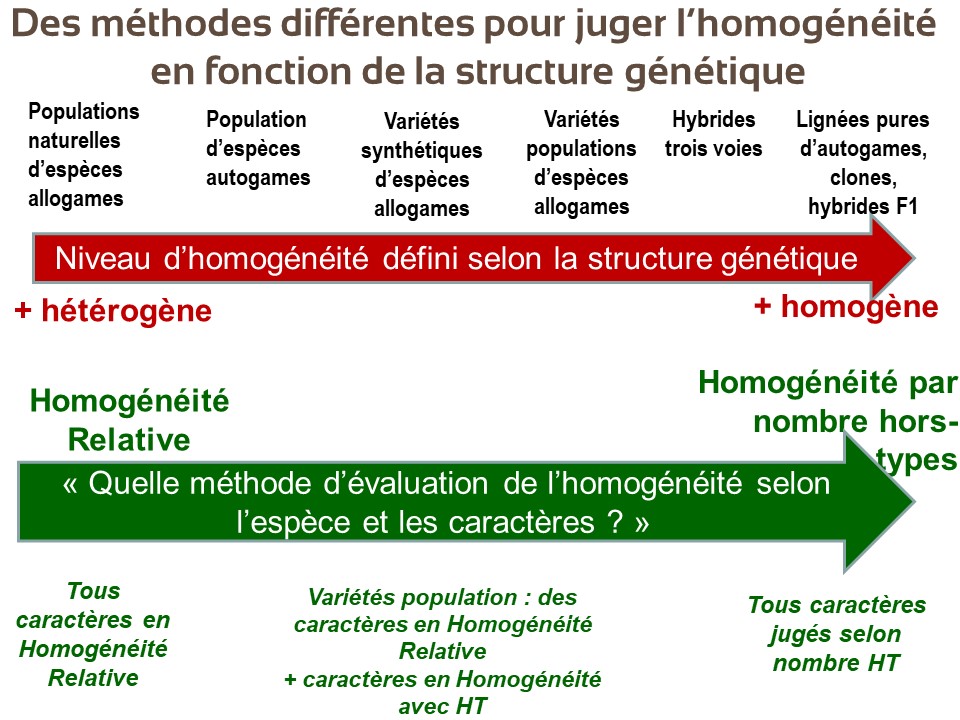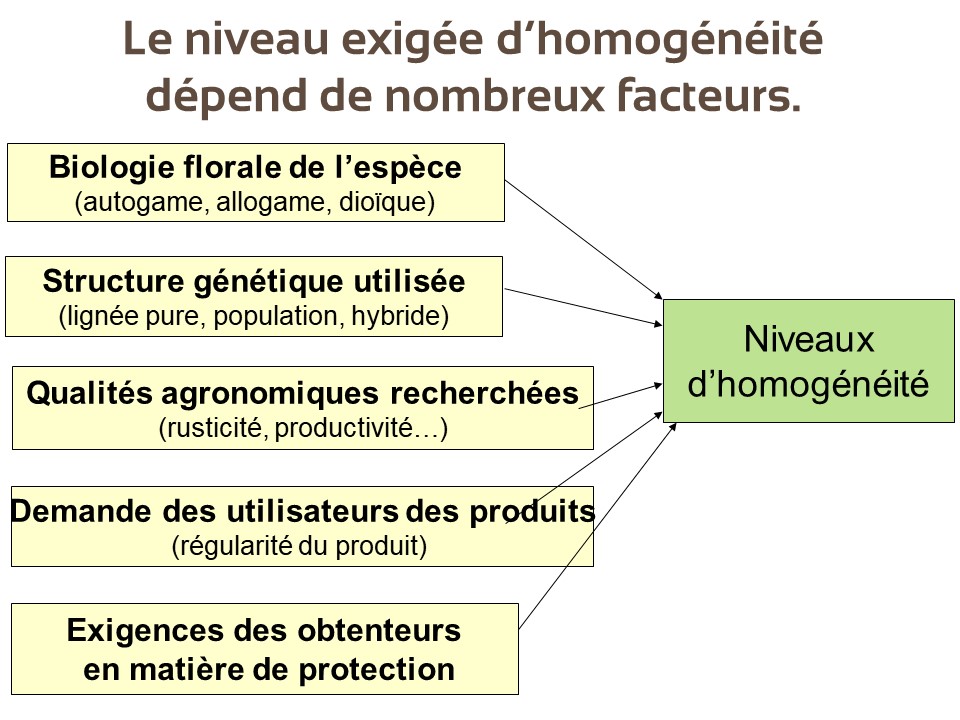Uniformity in DUS testing: a relative notion
Uniformity, the cornerstone of DUS testing, is a relative but necessary concept for the describing a variety.
In order to ensure fair trade, a new variety must be described; this will enable it to be identified in the field and be used to prevent errors, fraud and other misuse. This helps to ensure that the purchaser has indeed bought the variety he wishes to grow. The description is like an identity card for the variety.
This description is based on so-called “phenotypic” characteristics, i.e. corresponding to the expression of genes during plant growth, for example the shape of the fruit or seed, colour, size, plant habit, cut or corrugated leaves, ornamentation …
We mostly use stable characteristics as the basis for testing, i.e. characteristics whose expression is influenced as little as possible by environmental conditions, such as the shape of the organs, presence/absence of thorns, hairs, pigmentation, colour of flowers, etc. This provides a robust description which is identical regardless of the location or the year in which the variety is described. However, sometimes the species does not allow for a large number of these characteristics, so it is also possible to use slightly more fluctuating characteristics, such as plant height and earliness at flowering, which will then be noted in comparison with well-known reference varieties.
The characteristics used are as far as possible standardised internationally; it is one of UPOV’s main missions to bring together the best international expertise to establish “guidelines”, a kind of practical guide which details how to observe and describe a very large number of crop species.
In Europe, the harmonisation of methods is further enhanced by the requirements of the CPVO. The CPVO publishes “DUS test protocols” which the examination offices of the EU Member States must follow in order for their data sheets to be used for intellectual property purposes or for listing in the Official Catalogue.
The number of characteristics observed varies according to the species, but often fluctuates between 20 and 60 characteristics (some 90 characteristics for chrysanthemums!). It should be noted that although most of the characteristics are morphological (observable directly on the plant), biochemical type characteristics (contents of certain compounds) and pest resistance (which generally requires conducting tests with artificial contamination) are also taken into account.
A characteristic can take only 2 values (e.g. presence/absence of ornamentation), 3 or 4, or on the contrary potentially an infinity, in the case of measuring the size of an organ for example: but in the latter case, and by international convention, these measurements are converted into a note/class on a scale taking whole values from 1 to 9, e.g. 1 for very small varieties and 9 for larger ones.
The set of characteristics noted on a variety during its cycle is used to produce the variety description.

Each variety must be distinct from all other existing varieties!
Two varieties are declared distinct if they are distinguished by at least one of the observed characteristics. A single characteristic is therefore sufficient to differentiate two varieties. This means that the new “candidate” variety can be admitted as a “variety” in keeping with regulations, and that it is not just a simple copy of a pre-existing variety and that its denomination is validated.
By expanding this reasoning, it is therefore understood that each variety recognised as such is therefore distinct from all other existing varieties, by the expression of at least one of the characters used for the description.
If you use 10 characteristics which can each take 4 values, in theory you can describe 4 to the power of ten varieties, i.e. 1,048,576 different varieties! Enough to leave room for breeders to create new varieties. The magic of powers, made famous by the chess legend Sissa, is of great help here.
Obviously, to describe a variety, we do not observe just a single plant – that would of course be too risky, as a single plant is not necessarily representative of the variety. Not all the plants of a variety necessarily need to be identical, it all depends on the mode of reproduction of the species and the objective aimed at when creating the variety, as explained in the chapter what is a variety.
Uniformity is a guarantee of distinctness and stability
How can we describe a non-uniform variety?
It is understandable that too much intra-varietal heterogeneity makes it more difficult, if not impossible, to describe a variety. How can a description be provided if within the same variety one finds small and large plants, light and dark, smooth and corrugated leaves?
Too much heterogeneity also makes it harder or even impossible to distinguish from other varieties.
The more heterogeneous a variety is, the more difficult it will be to maintain the same plant over successive generations, which is called maintenance.
However, to ensure fair trade, the variety must be stable over time; the buyer must be able to find the variety he likes on the market.


It is therefore understandable that, although a certain degree of heterogeneity is possible within a variety, it is nevertheless necessary to set a technical limit, and therefore to require a variety to be relatively uniform. This is the exact meaning of the definition of uniformity given by UPOV:
A variety is deemed uniform if it is sufficiently homogeneous, having regard to the particular features of its sexual reproduction or vegetative propagation.” (Art.8 –UPOV Convention) |
So why must a variety be “sufficiently uniform”? To describe it, distinguish it from other varieties and ensure its stability over time.
Uniformity, a notion that can be relative…
When a population-type variety is observed, bearing in mind that it contains a “dose” of heterogeneity, a sufficient number of plants will be observed for it to be representative of the variety as a whole, and its uniformity will be judged relative to that of other known population varieties of the same species: based on this principle of relative uniformity, the variety being studied should not be more heterogeneous than other pre-existing population varieties.
This relative homogeneity can be assessed either by experts or by mathematical tests (of the standard deviation type).
For example, if the median score for an observed characteristic is 4, all plants which are recorded as 3, 4 or 5 and perhaps a few plants recorded as 2 or 6 would be accepted as part of the variety.
If being assessed by experts, the uniformity of varieties from populations of a large number of species is evaluated on the basis of all the characteristics being observed. A “candidate” population variety should not be more heterogeneous than pre-existing varieties. In a few cases, such as carrot, a “candidate” population variety should not be more heterogeneous than pre-existing varieties in the majority of morphological characteristics except for two characteristics, root colour and root core colour, for which uniformity will be assessed as for fixed varieties, i.e. the number of “off-types”.


...but stricter for "fixed" varieties
Today, population varieties account for a very modest proportion of varieties submitted for registration; most breeders create varieties that are intended to be uniform, i.e. made up of genetically identical plants, such as identical twins.
Depending on the way in which the species are propagated, these uniform varieties may be pure lines, F1 hybrids or clones.
In principle, for these uniform varieties, it is sufficient to observe only one plant or a very small number of plants to describe the variety; however, as there is always a risk of error, a set of plants will be observed, making it possible to identify “off-types”, i.e. plants which do not conform to the “standard” of the variety.
Taking the same example, in a characteristic noted 4 for a uniform variety, the vast majority of plants will be well observed in Note 4, and a plant noted 6 will be classified as an off-type.
Consequently, tolerated thresholds of off-types are established for each species, beyond which the “candidate” variety is considered as heterogeneous, in order to be accepted as a variety.
These thresholds are adapted to each species and to each genetic structure (lineage, hybrid, population, etc.). They depend in particular on the degree of fixity that is aspired to in the breeding process to ensure the distinction of a variety but also its stability over time.
The thresholds for admitting off-types generally vary between 0.5 and 2%. They can be stricter (as for self-pollinated cereals), or on the contrary more flexible for particular genetic constructs such as 3-way hybrids (crossing of a pure pollinator line and a female F1 hybrid) or hybrids using male sterility systems which require the mixture of the female parent and the pollinator to be marketed as a variety.
